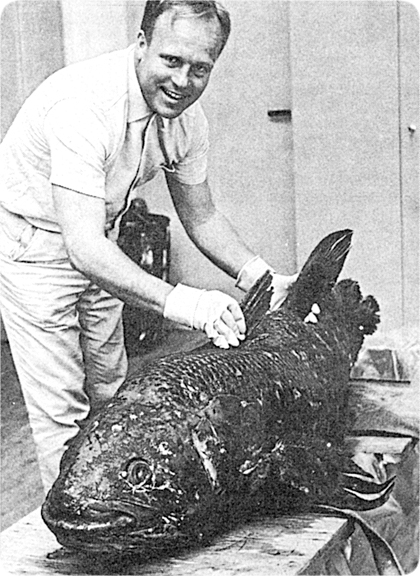Show your support by donating any amount. (Note: We are still technically a for-profit company, so your
contribution is not tax-deductible.)
PayPal Acct:  Feedback:
Feedback: 
Donate to VoyForums (PayPal):
| [ Login ] [ Contact Forum Admin ] [ Main index ] [ Post a new message ] [ Search | Check update time | Archives: 1, 2, [3], 4, 5, 6, 7, 8, 9, 10 ] |

Figure 29: 70,000,000-Year-Old Fish? Thought to have been extinct for 70,000,000 years, the coelacanth [SEE la kanth] was first caught in 1938, deep in the Indian Ocean, northwest of Madagascar. Rewards were then offered for coelacanths, so hundreds were caught and sold. In 1998, they were also found off the coast of Indonesia (c). How could the ancestors of these coelacanths leave no fossils for 70,000,000 years?
Before coelacanths were caught, evolutionists incorrectly believed that the coelacanth had lungs, a large brain, and four bottom fins about to evolve into legs (d). Evolutionists reasoned that the coelacanth, or a similar fish, crawled out of a shallow sea and filled its lungs with air, becoming the first four-legged, land animal. Millions of students have been erroneously taught that this fish was the ancestor of all amphibians, reptiles, dinosaurs, birds, and mammals, including people (Was your ancestor a fish?).
c. Peter Forey, “A Home from Home for Coelacanths,” Nature, Vol. 395, 24 September 1998, pp. 319–320.
Since the above discovery near Indonesia in 1998, most coelacanths are being caught off the coast of northern Tanzania, 500 miles north of what was thought to be their old habitats. [See Constance Holden, “Saving the Coelacanth,” Science, Vol. 316, 8 June 2007, p. 1401.]
d. “Zoologists originally thought that the paired fins of coelacanths and the fossil lobe-fins functioned as true limbs, as props to lever the fish against the solid substrate of the bottom sand or against rocks.” Keith S. Thomson, Living Fossil: The Story of the Coelacanth (New York: W. W. Norton & Co., Ltd., 1991), p. 160.
“...much attention has been focused on their fins in the hope that they will tell more about how fins became limbs.” Ommanney, p. 74.
“For the coelacanth was a member of a very ancient class of fishes which was supposed to have disappeared some 70 million years ago. This great group of fishes, called crossopterygians, flourished during that decisive era in the history of the earth—when the fish, taking on legs and lungs, went forth to conquer the continents.” Jacques Millot, “The Coelacanth,” Scientific American, Vol. 193, December 1955, p. 34.
Dr. Jacques Millot, who headed many detailed studies of freshly caught coelacanths, still held out hope as of 1955:
“Perhaps their stalked fins permit them to creep along the rocks like seals.” Ibid., p. 38.
This myth was buried only after Dr. Hans Fricke’s team observed coelacanths in their natural habitat in 1987. Their bottom fins have nothing to do with legs or creeping. Why did Millot ignore the facts he knew best? The coelacanth, he thought, solved a big problem. In 1955, Millot wrote:
“One of the great problems of evolution has been to find anatomical links between the fishes and their land-invading descendants...For a long time evolutionists were troubled by this major gap between fishes and the amphibians. But the gap has now been bridged by studies of ancient fishes, and this is where the coelacanth comes in.” Ibid., pp. 35–36.
Later (1987), after studying live coelacanths, the scientific world learned that Millot was wrong. The coelacanth did not bridge this gap. Therefore, the fish-to-amphibian problem is back.
“He [J. L. B. Smith] was able to report [in the journal Nature] that, like the lungfishes, the fish had an air bladder or lung (on the basis of the taxidermist’s report of the discarded viscera), which was a median rather than paired structure.” Thomson, Living Fossil, p. 39. [It is now recognized that the discarded “bag” was not a lung, but an oil-filled swimming bladder. W.B.]
[From “In the Beginning” by Walt Brown ]
[
Next Thread |
Previous Thread |
Next Message |
Previous Message
]
|
Forum timezone: GMT-8 VF Version: 3.00b, ConfDB: Before posting please read our privacy policy. VoyForums(tm) is a Free Service from Voyager Info-Systems. Copyright © 1998-2019 Voyager Info-Systems. All Rights Reserved. |